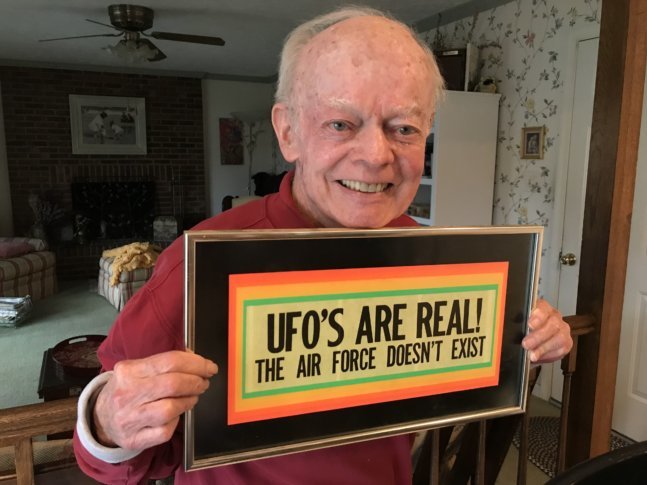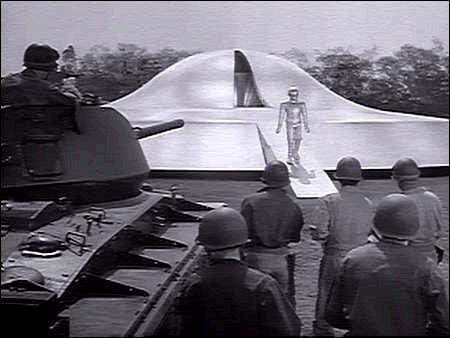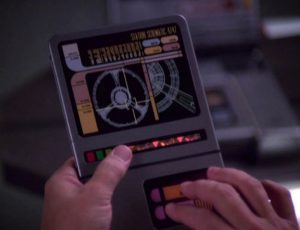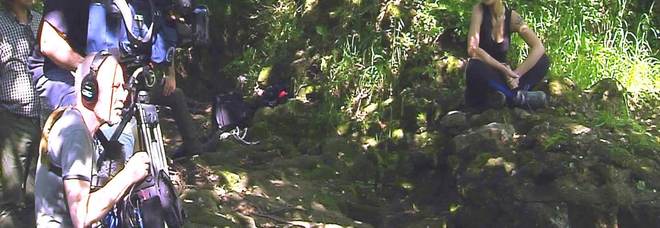“Show it to the National Academy of Sciences. Don’t hide it. Show it!
We’ve been waiting for it! We’ve been waiting for it forever,” retired
Air Force Col. David Shea said, raising his voice. “But so far, that
hasn’t happened, and I don’t know why.”
 |
| Shea holds a comical sign to hang in his office. It was given to him by journalist and UFO skeptic Phill Klass. |
Shea, 80, was the Air Force’s press spokesman on UFOs at the Pentagon
from 1967 to 1971. He considers himself an “agnostic” when it comes to
whether some unidentified flying objects are ships piloted by
intelligent beings from faraway worlds.
“I would believe if I saw some evidence that showed we were visited
by alien spacecraft, but there hasn’t been evidence to my mind of such,”
he said in an interview at his Northern Virginia home.
In 1969, Shea wrote the news release that announced the end of
Project Blue Book, an Air Force investigation of more than 12,000 UFO
reports.
It concluded that there was no threat to national security, no sign
of advanced technology and no evidence that UFOs are extraterrestrial.
And with that, it appeared to the public that the government had washed its hands of UFOs.
But in December, almost 50 years after Project Blue Book ended, came explosive news.
The New York Times reported that Bigelow Aerospace had been storing
material recovered from “unidentified aerial phenomena” in its buildings
in Las Vegas as part of a secret Pentagon UFO investigation project
called the Advanced Aerospace Threat Identification Program (AATIP).
Shea was not surprised by news of the project’s existence, but he
thinks if more people were aware of the government’s history with UFOs,
they would better understand why, in his opinion, the government should
not get involved again.
“The UFOs never seem to go away,” he said.
Government investigations and scientific studies
What is considered the modern UFO era began as Americans’ Cold War fears of the Soviet Union were heating up.
In 1947, a veteran pilot flying near Mt. Rainier in Washington
reported seeing nine strange objects flying in formation at incredible
speeds.
The sighting made national news, and the same year, the Air Force
(still the Army Air Forces at the time) began investigating — with
intelligence officers in charge — reports of UFOs.
“They really weren’t sure what was going on. But by the end of ’49
they quickly became convinced that there was no threat, and there was no
visitation, there was no advanced technology, and that was a good time
to get out of the business, but they didn’t,” Shea said.
The work went on under several code names including “Project Sign,” “Project Grudge” and “Project Blue Book.”
Scientists were asked to evaluate if the work should continue, first by the CIA in 1952 and then by the Air Force in 1966.
The latter study was led by physicist Edward Condon of the University
of Colorado. “He concluded that the continuation of Project Blue Book
is of dubious value,” said Shea.
In all, Project Blue Book examined 12,618 sightings reported between
1952 and 1969. Over 5 percent of those sightings — 701 — remain
unidentified. “Does that mean they were spacecraft from another
civilization? No, not necessarily. It just means there was not enough
data to verify what they were. So that’s the problem,” Shea said.
Interestingly, “Project Blue Book” is the name of
a new drama series that will begin airing this winter on the History Channel.
“It would appear that it will be more fiction than fact,” Shea said after reviewing promotional materials.
The History Channel describes the series as “based on the true,
top-secret investigations into Unidentified Flying Objects (UFOs) and
related phenomena conducted by the United States Air Force.” It also
says a central figure in the series, Dr. J. Allen Hynek, “is recruited
by the U.S. Air Force to spearhead a clandestine operation called
Project Blue Book.”
Shea said that Project Blue Book investigations were never top
secret, and that in real life, Hynek was hired by the Air Force as a
special consultant on UFOs, not to “spearhead” Project Blue Book.
Missteps and misunderstandings
Shea is a public relations pro who spent 29 years with the Air Force
and another 20-plus years working for Hughes Aircraft and, later,
Raytheon. To complete his master’s degree in mass communication from the
University of Denver in 1972, he wrote his thesis about how, from a PR
perspective, the Air Force handled reports of unidentified flying
objects.
“The story of the Air Force and UFOs is essentially a tale of a
credibility gap wider than the Grand Canyon,” Shea wrote. “During its
more-than-20-year history of investigating flying saucers, the Air Force
has been accused of almost every conceivable sin, and had been guilty
of most.”
In the 1940s and ’50s, UFO sightings that got press attention would
prompt a quick explanation from the Air Force. “In those early days, any
explanation of a sensational case seemed preferable to the Air Force
than simply saying, ‘We don’t know at this point, the case is still
under investigation,'” wrote Shea.
And because Air Force intelligence was kept in charge of the
investigations, Shea said, there was unnecessary secrecy. “You know the
intelligence people won’t tell their mother anything. They keep things
close to the vest,” he said.
Of course, the Air Force’s actions led to questions and skepticism.
“What was initially an intelligence matter quickly evolved into a PR
problem of the greatest magnitude,” Shea wrote. “The Air Force, ignoring
public opinion on the subject, failed to communicate its conviction
that UFOs were no cause for alarm and consequently was unable to
convince the American public that what it was saying about UFOs was
true. As a result the Air Force’s integrity and credibility as a
fighting force was seriously questioned.”
Asked if, to his knowledge, the government covered up evidence of
alien visitation in the past, Shea answered: “Absolutely not. It would
be impossible to do so in our environment of leakers and
whistleblowers.”
In its defense, Shea points out that the Air Force was placed in the
impossible position of trying to prove that aliens are not whizzing
around above Earth. “You can’t prove that something doesn’t exist. Why
doesn’t the other guy prove that it does exist?” he said.
He also thinks the Air Force has been misunderstood. “The Air Force
has never said that UFOs aren’t spacecraft from another civilization.
What the Air Force has said is that there’s no convincing evidence that
they present a threat, or they advance scientific knowledge, or that
they are alien spacecraft. Convincing evidence is the key, and that’s
what we don’t have,” said Shea.
What evidence would convince him that extraterrestrials have visited this planet?
“It would be great if an alien were to knock on the door of 1600
Pennsylvania Ave., but I don’t expect that to happen,” Shea said. “I
would be convinced of extraterrestrial visitation should someone or some
organization present to the National Academy of Sciences an ET piece of
hardware that the NAS declares not of earthly origin.”
Should investigations continue?
Despite what he called “exhaustive” investigations and studies of
UFOs, Shea said, the government has come up with nothing. “No eureka
moment. No threat. No advanced technology. No alien spacecraft,” he
said.
According to the Department of Defense, AATIP ended in 2012, but
journalist Leslie Kean reports there’s evidence that the program is
continuing without federal funding.
Shea doesn’t think that’s a good idea. “Why would the government want
to do that again?” He asked. “We’ve been there, done that.”
Some argue that UFOs determined by Project Blue Book to be
unexplained should be reinvestigated. “I submit it wouldn’t reveal
anything new. There’s not enough data there to analyze and determine
causes,” said Shea.
Regarding videos of UFOs apparently taken from military planes and
reportedly studied as part of AATIP, Shea said: “What did they see? Who
knows what they saw? Am I impugning their integrity? No. Not at all.
They saw something, but we don’t know what it is, and we don’t have the
evidence to suggest what it may be. So again, it comes back to the word
‘evidence.'”
Just because a military pilot spots or chases a UFO doesn’t mean the
unidentified object should be considered a threat to national security,
said Shea. “I would say we would be concerned if they were fired upon.
We would be concerned if they started bombing our bases. None of that
has happened, so whatever they’re seeing doesn’t seem to be hostile in
nature. Not to worry, is what I would say.”
To The Stars Academy of Arts & Science — a public benefit
corporation co-founded by musician Tom DeLonge and launched last year —
is pursuing its own UFO research. It includes several former government
higher-ups and is accepting money from investors.
“More power to them, I think they’re on a wild ghost chase. But I
think we need to have some interest in that,” said Shea. “If they come
up with something that the government hasn’t, great.”
Asked if he’s ever seen a UFO, Shea said no.
“You’d think with all my interest or experience in this, a friendly
visitor would come visit me. Hasn’t happened,” Shea said, laughing.
Video produced by Ginger Whitaker
By
Michelle Basch
Source News












